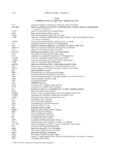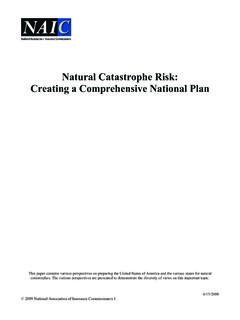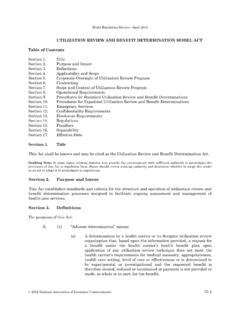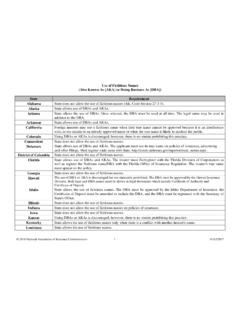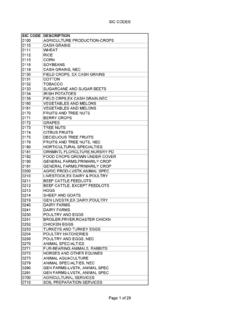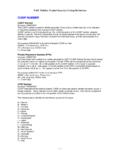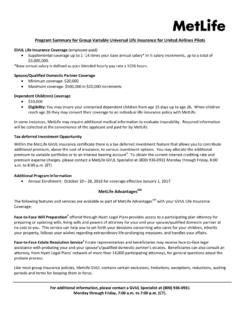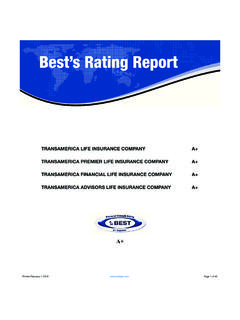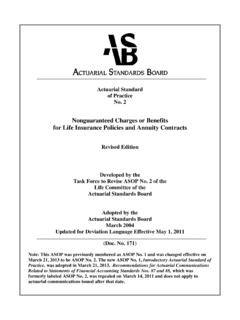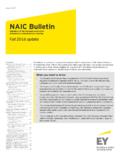Transcription of UNIVERSAL LIFE INSURANCE MODEL REGULATION Table ... - …
1 MODEL REGULATION Service January 2001 2001 National Association of INSURANCE Commissioners 585-1 UNIVERSAL life INSURANCE MODEL REGULATION Table of Contents Section 1. Authority Section 2. Purpose Section 3. Definitions Section 4. Scope Section 5. Valuation Section 6. Nonforfeiture Section 7. Mandatory Policy Provisions Section 8. Disclosure Requirements Section 9. Periodic Disclosure to Policyowner Section 10. Interest-Indexed UNIVERSAL life INSURANCE Policies Section 1. Authority This REGULATION is promulgated under the authority of Section [insert applicable section], of the INSURANCE Laws of [insert state], and is effective [insert date]. Section 2. Purpose The purpose of this REGULATION is to supplement existing regulations on life INSURANCE policies in order to accommodate the development and issuance of UNIVERSAL life INSURANCE plans. Drafting Note: It is the position of the drafters of this REGULATION that UNIVERSAL life INSURANCE is simply another competing type of life INSURANCE which should be treated, to the extent possible, in the same regulatory manner as other life INSURANCE products.
2 This REGULATION is designed to address those areas where UNIVERSAL life INSURANCE does not fit into the existing regulatory framework. This REGULATION does not supersede existing requirements relating to filing, solicitation, advertising, etc., but is supplementary to them. Section 3. Definitions As used in this REGULATION : A. Cash surrender value means the net cash surrender value plus any amounts outstanding as policy loans. B. Commissioner means the INSURANCE Commissioner of this state. Drafting Note: Insert the title of the chief INSURANCE regulatory official wherever the term commissioner appears. C. Fixed premium UNIVERSAL life INSURANCE policy means a UNIVERSAL life INSURANCE policy other than a flexible premium UNIVERSAL life INSURANCE policy. D. Flexible premium UNIVERSAL life INSURANCE policy means a UNIVERSAL life INSURANCE policy which permits the policyowner to vary, independently of each other, the amount or timing of one or more premium payments or the amount of INSURANCE .
3 E. Interest-indexed UNIVERSAL life INSURANCE policy means any UNIVERSAL life INSURANCE policy where the interest credits are linked to an external referent. Drafting Note: This definition is not intended to include those policies which only have a variable policy loan interest rate provision, but have no other link to an external referent. This REGULATION presently addresses only the indexing of interest credits. The REGULATION does not preclude the indexing of other factors, , mortality or expenses. Should other products be developed which involve the indexing of factors other than interest credits, this REGULATION may require modification. The REGULATION does not preclude INSURANCE departments from adding requirements regarding the indexing of such other factors. F. Net cash surrender value means the maximum amount payable to the policyowner upon surrender. UNIVERSAL life INSURANCE MODEL REGULATION 585-2 2001 National Association of INSURANCE Commissioners G.
4 Policy value means the amount to which separately identified interest credits and mortality, expense, or other charges are made under a UNIVERSAL life INSURANCE policy. Drafting Note: UNIVERSAL life INSURANCE policies may use designated amounts for different purposes. These include the following: the base upon which interest credits are calculated; the amount subtracted from the policy s face value to determine net amount at risk for calculation of mortality charges, and the amount paid upon surrender. These amounts may all be the same or may be different. For purposes of this REGULATION , these amounts do not define policy value, although they may be coincidentally equal to that amount as defined above. Care should be taken not to place undue emphasis on the policy or account value. Very often the policy value is not directly available to the policyowner. Instead, the policy value is an intermediate step used to determine benefits actually available to the policyowner such as cash surrender values, net cash surrender values, death benefits, or maturity values.
5 The benefits actually provided the policyowner should be considered in establishing valuation and nonforfeiture standards. H. UNIVERSAL life INSURANCE policy means a life INSURANCE policy where separately identified interest credits (other than in connection with dividend accumulations, premium deposit funds, or other supplementary accounts) and mortality and expense charges are made to the policy. A UNIVERSAL life INSURANCE policy may provide for other credits and charges, such as charges for the cost of benefits provided by rider. Drafting Note: This REGULATION is specifically designed for individual life INSURANCE policies. It is not intended, however, to prohibit the issuance of group UNIVERSAL life INSURANCE policies. States are free to adopt whatever portions of this REGULATION which are appropriate for group INSURANCE and which are in accordance with state law. Unlike the unitary nature of traditional whole life INSURANCE , a distinguishing feature of UNIVERSAL life INSURANCE is the existence of an indeterminate policy value from which specified periodic charges are deducted and to which specified periodic interest is credited at a rate not determined at issue.
6 This indeterminate policy value feature with separately identified charges and credits may or may not have a premium pattern predetermined by the insurer at issue. Valuation and nonforfeiture treatment of these products varies depending upon the nature of the premium pattern. To distinguish these treatments, a definitional distinction has been made between flexible and fixed premium policy forms. Section 4. Scope This REGULATION applies to all individual UNIVERSAL life INSURANCE policies except variable UNIVERSAL life . Section 5. Valuation A. Requirements The minimum valuation standard for UNIVERSAL life INSURANCE policies shall be the Commissioners Reserve Valuation Method, as described below for such policies, and the tables and interest rates specified below. The terminal reserve for the basic policy and any benefits and/or riders for which premiums are not paid separately as of any policy anniversary shall be equal to the net level premium reserves less (C) and less (D), where: Reserves by the net level premium method shall be equal to ((A)-(B))r where (A), (B) and r are as defined below: (A) is the present value of all future guaranteed benefits at the date of valuation.
7 (B) is the quantity PVFB ax+t ax where PVFB is the present value of all benefits guaranteed at issue assuming future guaranteed maturity premiums are paid by the policyowner and taking into account all guarantees contained in the policy or declared by the insurer. ax and ax+t are present values of an annuity of one per year payable on policy anniversaries beginning at ages x and x+t, respectively, and continuing until the highest attained age at which a premium may be paid under the policy. The letter x is defined as the issue age and the letter t is defined as the duration of the policy. MODEL REGULATION Service January 2001 2001 National Association of INSURANCE Commissioners 585-3 The guaranteed maturity premium for flexible premium UNIVERSAL life INSURANCE policies shall be that level gross premium, paid at issue and periodically thereafter over the period during which premiums are allowed to be paid, which will mature the policy on the latest maturity date, if any, permitted under the policy (otherwise at the highest age in the valuation mortality Table ), for an amount which is in accordance with the policy The guaranteed maturity premium is calculated at issue based on all policy guarantees at issue (excluding guarantees linked to an external referent).
8 The guaranteed maturity premium for fixed premium UNIVERSAL life INSURANCE policies shall be the premium defined in the policy which at issue provides the minimum policy The letter r is equal to one, unless the policy is a flexible premium policy and the policy value is less than the guaranteed maturity fund, in which case r is the ratio of the policy value to the guaranteed maturity fund. The guaranteed maturity fund at any duration is that amount which, together with future guaranteed maturity premiums, will mature the policy based on all policy guarantees at issue. (C) is the quantity ((a)-(b))ax+t r where (a)-(b) is as described ax in [insert reference to Section 4 of the Standard Valuation Law] for the plan of INSURANCE defined at issue by the guaranteed maturity premiums and all guarantees contained in the policy or declared by the insurer. ax+t and ax are defined in (B) above. (D) is the sum of any additional quantities analogous to (C) which arise because of structural changes3 in the policy, with each such quantity being determined on a basis consistent with that of (C) using the maturity date in effect at the time of the change.
9 The guaranteed maturity premium, the guaranteed maturity fund and (B) above shall be recalculated to reflect any structural changes in the policy. This recalculation shall be done in a manner consistent with the descriptions above. Future guaranteed benefits are determined by (1) projecting the greater of the guaranteed maturity fund and the policy value, taking into account future guaranteed maturity premiums, if any, and using all guarantees of interest, mortality, expense deductions, etc., contained in the policy or declared by the insurer; and (2) taking into account any benefits guaranteed in the policy or by declaration which do not depend on the policy value. All present values shall be determined using (i) an interest rate (or rates) specified by [insert reference to the Standard Valuation Law] for policies issued in the same year; (ii) the mortality rates specified by the [insert reference to the Standard Valuation Law] for policies issued in the same year or contained in such other Table as may be approved by the Commissioner for this purpose; and (iii) any other tables needed to value supplementary benefits provided by a rider which is being valued together with the policy.
10 Drafting Note: To the extent that the insurer declares guarantees more favorable than those in the policy (contractual guarantees), such declared guarantees shall be applicable to the determination of future guaranteed benefits. The mortality and interest bases for calculating present values are the minimum standards in the Standard Valuation Law. Ever since the adoption of the original Standard Valuation Law (SVL) in 1942, provision has been made for valuation calculations on the basis of substandard mortality. (See Section 4G of SVL). While this provision has been used infrequently in the past, it is anticipated that substandard mortality will be more frequently utilized in UNIVERSAL life INSURANCE , given its flexible nature, to reflect the mortality classification assigned to the policy by the insurer. In effecting structural changes, consistent methods are prescribed when calculating reserves. Several such methods are possible, but perhaps the simplest such method would be that of maintaining proportionality between the Guaranteed Maturity Fund and Guaranteed Maturity Premium values and the current face amount.

